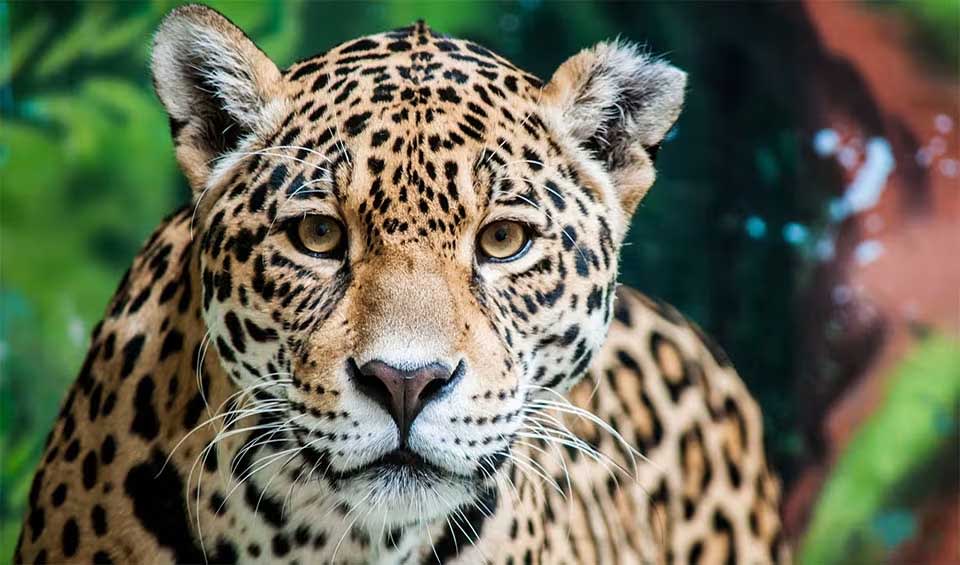This majestic animal boasts the most powerful bite among all felids, a trait that empowers it to easily break the bones of its prey. This incredible strength is not merely a function of raw power but a critical adaptation that allows the jaguar to secure a diverse diet, ranging from fish and reptiles to large mammals, showcasing its versatility and skill as a hunter.
The jaguar’s prowess extends beyond the land; it is an adept swimmer, distinguishing it from many of its feline counterparts. This affinity for water plays a significant role in the jaguar’s survival, especially given its extensive range of habitats, including wooded regions, tropical forests, and wetlands. The ability to hunt in water grants the jaguar access to aquatic prey, further diversifying its diet and reinforcing its status as an apex predator. Within these varied ecosystems, the jaguar reigns supreme, facing no natural predators other than the most dangerous of all—humans.
Historically, human activities have posed a significant threat to jaguar populations. Relentless hunting and habitat destruction in the United States led to the jaguar’s extinction. However, in South America, where the jaguar is deeply intertwined with the cultural fabric and biodiversity of the region, populations have fared better, though they are not without their challenges.
The jaguar’s role as an apex predator is crucial for maintaining the balance of the ecosystems it inhabits. By regulating prey populations, jaguars help to prevent overgrazing and maintain the health of their environments. This ecological impact underscores the importance of jaguar conservation efforts, not only for the species itself but for the broader health of their habitats.
Distribution
 Argentina
Argentina Official estimate
Official estimate
 Belize
Belize Official estimate
Official estimate
 Bolivia
Bolivia Official estimate
Official estimate
 Brazil
Brazil Official estimate
Official estimate
 Colombia
Colombia Costa Rica
Costa Rica Ecuador
Ecuador Official estimate
Official estimate
 El Salvador
El Salvador Official estimate
Official estimate
 French Guiana
French Guiana Guatemala
Guatemala Official estimate
Official estimate
 Guyana
Guyana Honduras
Honduras Mexico
Mexico Official estimate
Official estimate
 Nicaragua
Nicaragua Panama
Panama Paraguay
Paraguay Official estimate
Official estimate
 Peru
Peru Official estimate
Official estimate
 Suriname
Suriname United States
United States Official estimate
Official estimate
 Uruguay
Uruguay Official estimate
Official estimate
 Venezuela
VenezuelaRecent updates
Jan 2023: Researchers of an international investigation have reported a concerning discovery: online trade of jaguar parts is openly detectable on multiple online platforms, posing a serious risk to jaguar populations across Latin America.
Oct 2021: Brazilian scientists are conducting experiments with frozen jaguar semen in an attempt to aid in the preservation of the species.
Did you know?
- The Jaguar is the sole surviving species of Panthera in the New World, making it the biggest cat in the Americas. They are the third biggest cat in the world.
- The Native American term yaguar, which means “he who kills with a single leap,” is where the name “jaguar” originates. Unlike other big cats, they attack the prey’s skull rather than the throat.
- The black spots on their fur, known as “rosettes” because they are patterned like roses, are similar to leopards’, although jaguar rosettes contain spots inside them, whereas leopard rosettes are hollow.
- Jaguars have traditionally been viewed as loners, but studies published in the journal Behavioral Ecology and Sociobiology suggest that male jaguars occasionally band together to form coalitions.
- Jaguars are believed to occupy only around 51% of their historical range, having completely vanished from about half of the previous range.
- The species is more firmly linked with water than any other big cat, and it is exclusively found near waterways. This trait swiftly brings them into conflict with the spread of agriculture, which has the same nearby water sources for irrigation requirements.
- Commercial hunting and trafficking of Jaguars for their pelts had decreased dramatically since the mid-1970s when anti-fur campaigns and CITES regulations gradually closed down worldwide markets.
- Jaguars are being used as substitutes for tiger bones by Latin America’s growing Asian community.
- A recent analysis from the Wildlife Conservation Society revealed the purchasing and selling of trafficked jaguar parts online in Latin America, with little to no response from law enforcement,
- Jaguar populations are being reduced and isolated across their range due to habitat destruction and fragmentation.
Anything we've missed?
Help us improve this page by suggesting edits. Glory never dies!
Suggest an editGet to know me
Terrestrial / Aquatic
Altricial / Precocial
Polygamous / Monogamous
Dimorphic (size) / Monomorphic
Active: Diurnal / Nocturnal
Social behavior: Solitary / Pack / Herd
Diet: Carnivore / Herbivore / Omnivore / Piscivorous / Insectivore
Migratory: Yes / No
Domesticated: Yes / No
Dangerous: Yes / No
Jaguar on banknotes










